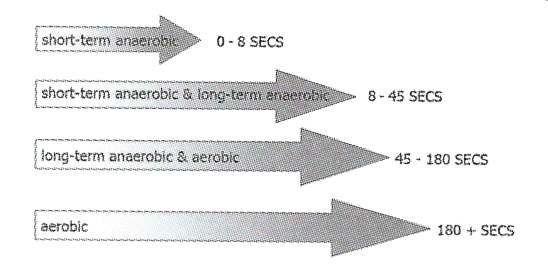Fitness Training for Trampoline
By Simon Breivik MSc. BSc.(Hons)
There is no doubt that success in Gymnastics, whatever the discipline, relies predominantly on technical ability. And in my four years as sports scientist to British Gymnastics I have come to terms with the fact that physical training will take a back seat to technical training. This is to be expected, it is a technical sport that demands hours of practicing skills in the gym. But I frequently hear suggestions that gymnasts receive adequate conditioning from their technical training. Although gymnasts certainly receive some conditioning from technical training, I do not feel that we should settle for it as adequate.
Stand next to a gymnast who has just completed full routine and listen to their breathing — they have clearly worked very hard. Their ‘engine fitness’, as I call it, has clearly played a significant role in their performance. Of course a gymnast will always be tired and out of breath after a routine because they will give it 100% but the way I look at it — the fitter the gymnast, the more he or she will get for their effort.
In this article I will discuss ‘Metabolic Fitness the driving force behind a routine.
THE ENERGY SYSTEMS
To improve fitness specifically for gymnastics, fitness training must address the physical demands of the sport — this is the key.
So the first step to sport-specific fitness training is uncovering the physical demands of the sport. And to do this we need to understand how our body turns the energy tied up in food and drink into muscular movement.
Whether you’re a sprinter, a rock-climber or a trampolinist, there are just three ways in which your body supplies your muscles with energy — one requires the use of oxygen (aerobic) and two do not (both anaerobic).
You’re probably wondering how your body decides which to use. This depends on two things: 1) the intensity of the activity and 2) the duration of the activity.
THE SHORT-TERM ANAEROBIC SYSTEM - Explosive Power
When you require a brief but maximal effort, such as that needed to lift a heavy weight or to sprint 50m,the energy required is supplied by the Short-Term Anaerobic system. By breaking down high-energy phosphates stored within the muscles, this system can provide an immediate and powerful energy supply.
The downside to this energy system is that it can only fuel up to 8 seconds of maximal effort. So even the 100m sprint, which is considered to be one of the most explosive of sports, lasts too long for this system to supply 100% of its energy supply. In fact there are not many sports where this system is used exclusively, but examples would include weight lifting, and field events.
THE LONG-TERM ANAEROBIC SYSTEM - Lactic Acid System
By using the muscle’s carbohydrate (glycogen) stores through a process called anaerobic glycolysis, our Long-Term Anaerobic system provides a relatively quick release of energy lasting up to 180 seconds. This energy supply is put to use when activity is too intense for our body to fuel it aerobically (see below) or when maximal exercise continues for more than 8 seconds (see above).
The energy provided by this system is not released as quickly as that released by the short-term anaerobic system so it is less powerful but it will provide energy quicker than the aerobic system, thus fuelling a relatively powerful bout of exercise lasting between 8 seconds and 3 minutes. Sports that rely predominantly on this system for energy production include the 400m sprint, 100m & 200m Swim, most Artistic Gymnastics routines and Trampoline.
The down-side of this system, however, is the associated production of a substance called lactic acid, which accumulates in the blood and ultimately causes fatigue — this is the stuff that makes your legs feel heavy towards the end of a routine.
THE AEROBIC SYSTEM - Long and Steady
The Aerobic system supplies energy forrelatively low-intensity exercise and for prolonged periods of time. It uses oxygen from the air we breathe, fat (and to a lesser extent carbohydrate) to release energy relatively slowly. In theory we can operate aerobically forever, as long as we have a fat and carbohydrate supply to fuel it — it works on a ‘pay as you go’ basis.
Your aerobic fitness will power an activity as long as it is efficient (‘fit’) enough to supply your muscles with the oxygen needed.
However, as the intensity of exercise increases, there will come a point when our aerobic system will start to struggle to provide the oxygen needed to sustain aerobic activity. At this point our Long-term Anaerobic energy system will come to the rescue. But as mentioned above, this will only last a few minutes before the accumulation of lactic acid causes fatigue forcing the intensity to drop back into the aerobic zone.
Athletes requiring a high level of aerobic fitness include long-distance runners, cyclists, squash players and rowers.
THE IMPLICATIONS
It is important to understand that there is a spectrum of energy supply (Fig 1) and that the body will switch between the three energy systems depending on the intensity and duration of the activity being performed. In other words, you can mix and match during a single activity or sport.
You could liken this, very loosely, to the gears of a car representing the energy systems. If your ‘sport’ was to accelerate over a distance of 50m, you would just use your car’s first gear — your short-term anaerobic system. If you were required to accelerate your car over a longer distance, 500m, then you would need to make use of your second and third gear as well — your long-term anaerobic system. For a long-distance drive you would move your car up through the gears and spend most of the journey in fifth gear — your aerobic system. Figure 1 shows the interaction that occurs between the three systems during activities of varying durations.

Fig 1 - Interaction of Energy Sources during Exercise
The good news for gymnasts is that it is possible to improve the performance of each energy system by training — unfortunately you cannot do this with your car. And to improve gymnastics fitness you will need to train the energy systems that are appropriate to gymnastics.
In 2002, I conducted some research with the GB National Trampoline Squad. I took blood lactate recordings and heart rate measurements to determine which energy systems were dominant during trampoline. Figure 2 shows an estimate of the energy systems used during a trampoline routine, based upon my findings.

Fig 2 - Energy Supply for Trampoline
TRAINING IMPLICATIONS
My data reveals that the Long-Term Anaerobic system contributes the majority of the energy used during a trampoline routine — with a reasonable amount of energy supplied through the aerobic pathway. As a sports scientist I can use this information to construct a training programme designed specifically for trampolinists.
The programme must: A) focus on the energy systems in need of improvement, B) effectively overload the athlete’s current level of fitness so that improvements will take place and C) overload the trampolinist’s trampoline-specific muscles.
TRAINING THE LONG-TERM ANAEROBIC SYSTEM
As discussed, training must overload the Long-Term Anaerobic system in the most sport-specific manner possible. A runner should run, a swimmer should swim, a cyclist should cycle so a trampolinist should trampoline.
Unfortunately, this form of training will require extreme physical effort and therefore a lot of motivation! A training session should consist of repetitions of 45-60-second bouts of near-maximal exercise with 3 to 5 minutes of recovery in between. The work-to-rest ratio and the number of repetitions and sets performed should be adapted to the individual and be manipulated as they get fitter.
Performing the repetitions will result in ‘Lactate Stacking’ where the gymnast’s blood lactate increases to levels far higher than the level after a single maximal bout. This means that recovery after such a training session takes considerable time. It is for this reason that I suggest these sessions are programmed in at the end of technical training. It is also why I suggest no more than two of these sessions per week.
Aerobic fitness is also important and should be carried out predominantly in the closed season.
ACTIVE RECOVERY
During my research with the squad I also discovered that there was a lactate stacking effect taking place during technical training. Unlike during a fitness training session where this is the desired outcome, during technical training this accumulation of lactate will simply add to fatigue and cause the demise of both performance and concentration levels.
Performing light aerobic exercise during recovery from anaerobic exercise has been shown to accelerate blood lactate removal from affected muscles — which results in quicker recovery than passive recovery — sitting around. With this in mind, I strongly advise the use of ‘Active Recovery’ between bouts on the trampoline to improve recovery and increase the productivity of a technical session. So instead of sitting down between efforts on the trampoline, gymnasts should perform light aerobic exercise to assist in the removal of blood lactate from the trampoline-specific muscles. The mode of exercise used could be cycling, very light bouncing or walking around the gym.
This practice can actually be used as a training session in its own right. Twenty to twenty-five minutes of gentle swimming or cycling at a low-intensity will help prepare the gymnast recover more quickly thus preparing them better for subsequent training sessions. Such ‘recovery training sessions’ should be performed as frequently as possible — and preferably after each fitness training session.
SUMMARY
Time is of the essence in most gyms around the country and there is generally very little opportunity for fitness training. I am aware that, because training the Long-Term Anaerobic system produces high levels of fatigue, subsequent technical training will be compromised. l therefore recommend that fitness training sessions are performed at the end of technical training and that the sessions are fit carefully into the weekly technical training programme.
I am quite confident that trampolinists will benefit quite significantly from just one or two 30-min sessions per week of appropriate fitness training.
© Simon Breivik
 ®
®









